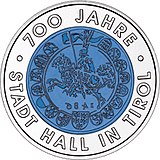Guldengroschen
| Guldengroschen | |
|---|---|

| |
O •SIGISMVNDVS: *: ARCHIDVX• AVSTRIE•, Sigismund standing in armor, wearing crown and holding orb; shield to left, crested helmet to right
|
R Armored knight on horseback right, carrying banner; arms of Austrian provinces around. |
| Sigismund, Archduke of Austria. 1427-1496. | |

The Guldengroschen or Guldiner was a large silver coin originally minted in Tirol in 1486, but which was introduced into the Duchy of Saxony in 1500.[1]
The name "Guldengroschen" came from the fact that it has an equivalent denomination value in silver relative to that of the that were in use.
In 1484, small numbers of "half guldengroschens" valued at 30 kreuzer were issued. This was a revolutionary leap in denomination from the smaller pieces, and surpassed even the large testones of Italy which were the highest weight coins in use. Finally, in 1486 the full sized guldengroschen of 60 kreuzers was put into circulation and it was soon nicknamed "Guldiner". For a long time thereafter such coins were also called "unciales" because their actual silver weight was very nearly one ounce. As large quantities of silver became available other states began issuing guldiners of their own. Bern, in modern-day Switzerland was one of the earliest to follow the County of Tyrol by issuing its guldiners in 1493. In 1500, Saxony's mint at Annaberg took minting of guldiners to new heights and the economies of central Europe welcomed these large new coins.

The original Tyrolean guldiner was designed so that eight coins minted would weigh in pure silver at one Tyrolean Mark. This was fine for the Tyrol, but much of Europe was accustomed to measuring by the more widely used
The 1524

Guldengroschen represented in other coins
Guldengroschen itself, has been the main motive for many collectors coins and medals. One of the most recent is the Austrian
References
Literature
- Miller, Manfred (2020). Münzverwaltungslehre at academia.edu. Retrieved 30 May 2022.
